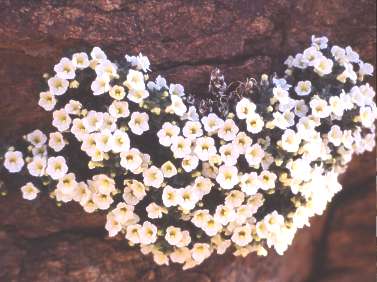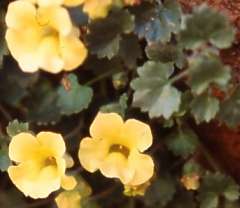Colpias mollis
Colpias mollis E.Mey. ex Benth.
Family: Scrophulariaceae
Common names: klipblom (Afr.)
Introduction

Description
Description

It is a low, much-branched shrublet, up to 200 mm high, with brittle branches. The leaves and branches are covered with soft hairs and during spring the small plants produce showy clusters of white or yellow flowers with a sweet or clove-like scent.
The leaves are alternate, hairy, egg-shaped or triangular, with toothed or incised margins. The perianth is divided into a five-partite calyx covered with soft hairs and a tubular corolla, hairless and somewhat curved at the base with two short pouches, lined with oil-secreting trichomes.
The capsules are hairless, dehiscent along the partition and contain many oblong, black seeds covered with small grains and wrinkles.
Distribution and habitat
Distribution description
Colpias is confined to crevices in granite boulders throughout Namaqualand. These plants are not restricted to a certain aspect or slope type, but literature suggests that plants generally occupy east- or south-facing rock faces. Plants have to withstand not only a shortage of water and nutrients, but also wide temperature fluctuations without the shading benefits provided by neighbouring plants.
Derivation of name and historical aspects
History
The genus Colpias consists of a single species which is endemic to the dry northwestern parts of South Africa and possibly Namibia. The species name mollis means softly hairy and refers to the leaves and branches that are covered with soft hairs. The name Colpias is derived from the Greek Kolpos meaning a breast or womb and probably refers to the two pouches in the corolla tube which resemble breasts.
Ecology
Ecology

The flowers of Colpias last four to five days and are pollinated by a specific Rediviva bee (Hymenoptera, Melittidae). The female bees collect oil and pollen from the flowers, while the males patrol the plants, presumably in search of receptive females. Pollen grains of Colpias are small (± 23 µm), have a semi-reticulate surface pattern (net-like, with holes and walls) and show a tendency to stick together-an adaptation ensuring easy attachment and transfer.
Appendages, called elaiosomes, containing lipid reserves are found on the seeds, and ants are therefore suspected to be responsible for dispersal of seeds to favourable microsites where germination occurs. However, after fertilization, the flower stalks turn away from the sunlight in the direction of the rock. This phenomenon is described as a type of autochory (the plant itself acting as dispersal agent) as the plant seeks a crack where the capsule deposits its seeds. Seeds thus germinate under the same conditions as the mother plant and survival of the species is ensured.
Uses
Use

Growing Colpias mollis
No information on the cultivation of this plant is available. Personal observations, however, showed that seeds germinate readily within a few days but after a week or two the seedlings start to wither and die, possibly as a result of a fungal infection.
This species has horticultural potential as the plants would make beautiful, unusual rockery subjects and would also look most decorative if grown between the rocks of a garden wall in the winter rainfall area.
Hester Steyn National Herbarium, Pretoria July 2004 .
References
- Cowling, R.M. & Pierce, S.M. 1999. Namaqualand. A succulent desert. Fernwood Press, Vlaeberg, Cape Town.
- Eliovson, S. 1972. Namaqualand in flower. Macmillan, Johannesburg.
- Jackson, W.P.U. 1990. Origins and meanings of the names of South African plant genera. UCT Ecolab, Rondebosch.
- Le Roux, A. & Schelpe, E.A.C.L.E. 1988. Namaqualand. South African Wild Flower Guide 1. Revised edition. Botanical Society of South Africa, Cape Town.
- Patterson-Jones, C. 1997. The Cape Floral Kingdom. New Holland, London.
- Steiner, K.E. & Whitehead, V.B. 2002. Oil secretion and the pollination of Colpias mollis (Scrophulaceae). Plant Systematics and Evolution 235: 53.
Credits
AuthorHester Steyn
National Herbarium, Pretoria
July 2004
Plant Attributes:
Plant Type: Shrub
SA Distribution: Northern Cape
Soil type:
Flowering season: Spring, Winter
PH: Acid, Neutral
Flower colour: White
Aspect: Full Sun
Gardening skill: Challenging
Special Features:
Horticultural zones








Rate this article
Article well written and informative
Rate this plant
Is this an interesting plant?
Login to add your Comment
Back to topNot registered yet? Click here to register.